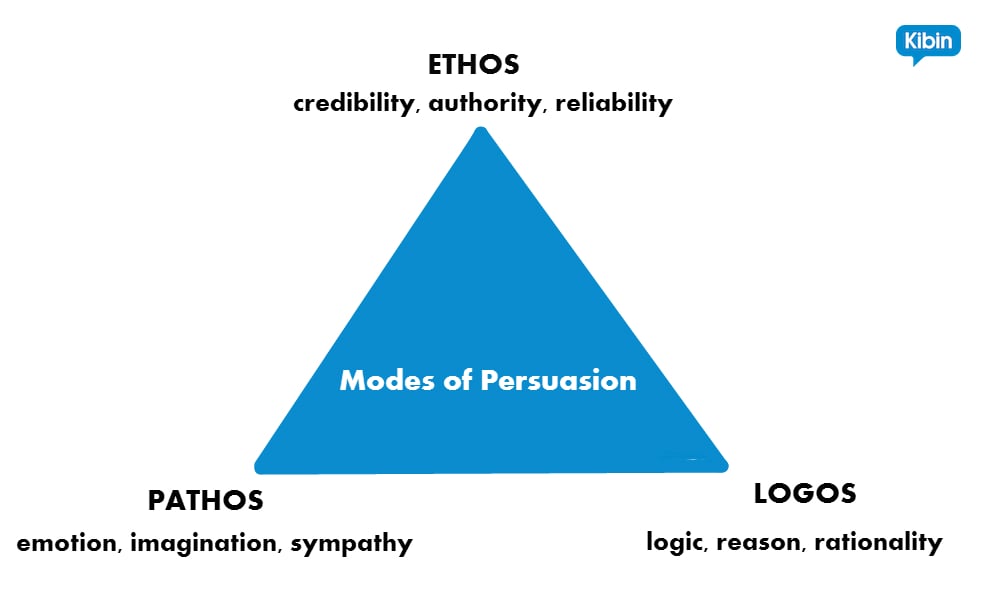Think back to the last time you tried to persuade someone to do something or to see an issue from your point of view. Did you succeed in convincing your teacher to give up grading or your parents to continue paying your cell phone bill for another year?
No? Probably because you were using the wrong modes of persuasion.
“Let’s see. I tried begging, whining, pleading…,” you might say.
Ack! Well there’s your problem. Those tricks might work for toddlers, but now that you’re a real-life grown-up, it’s time to add a little somethin’-somethin’ to your game if you want to get your way.

First, a little history lesson: way back in the day–the fourth century B.C., to be exact–the Greek philosopher Aristotle wrote On Rhetoric, a huge treatise on the art of, well, convincing people to see things your way. In it, he outlines three modes of persuasion: ethos, pathos, and logos. These three terms refer to three specific ways of appealing to an audience.
Over 2,000 years later, Aristotle’s ideas are still central in the field of rhetoric (which is the art of discourse). Let’s unpack each of these concepts and figure out how you can apply ethos, pathos, and logos to your next persuasive essay and win the hearts and minds of your audience….or at least get your way.
Ethos, Pathos, Logos: What Do They Mean?
Ethos, pathos, and logos are central to the art of persuasion. So central, in fact, that you encounter them every single day, whether you know it or not. Let’s break them down and look at some examples of each, shall we?
Ethos
If you’ve ever heard the question, “And just who are you to tell me…?”, then you know that someone’s argument lacks ethical appeal.
“Ethos” refers to one’s own character, image or reputation in the eyes of an audience. We see ethos in action all the time. Politicians, for instance, rely heavily on ethical appeals and will toot their own horns relentlessly to establish themselves as trustworthy, credible individuals.
You also see ethical appeals in television commercials: think about how many times you’ve heard things like “As a dentist, I recommend SparkleBrite toothpaste…” Or think about how often you see actors donning white coats to hawk aspirin and other medications on TV. To audience members, those titles and costumes = credibility.
Pathos
“Pathos” refers to appeals to your audience’s emotions, imaginations, or sympathies. Pathetic* appeals might tug at the audience’s heartstrings or get them fired up about some cause–these appeals rouse feelings of fear, pity, anger, and so forth.
If you’ve ever seen one of Sarah McLachlan’s ASPCA commercials and now tear up every time you hear “Angel” in passing, you’ve experienced the power of the pathetic appeal.
(*Not “pathological,” as many believe.)
Logos
“Logos” aren’t just brand symbols. In the context of rhetoric, logos refers to appeals to an audience’s sense of logic, reason, and rationality. Logical appeals are common in courtrooms, where evidence is used to support claims.
Logos also has to do with the way an argument is put together, whether in speech or in writing. The careful construction of a closing statement — which likely includes pathetic and ethical appeals, too — reflects the concept of logos.
Here are all three concepts distilled into one handy visual guide:
Now that you know what each of these concepts means, let’s look at how you can put them to work in your next persuasive essay.
How to Use Ethos, Pathos, and Logos in Persuasive Writing
So let’s pretend your teacher has assigned a persuasive essay. You, having just arrived to class from an expensive visit to your chiropractor, set down your 50-pound backpack and decide to write an essay persuading your school to abandon physical textbooks in favor of all-digital class materials.
To ensure that your argument hits all the right notes with all the right people, use these tips and strategies for enhancing your persuasive essay with ethos, pathos, and logos.
Tips for Applying Ethos in Your Writing

Strategy 1 — Show that you have good character by establishing your own credibility: “As a busy and studious college student, I carry all 45 pounds of my books to and from class each day.” (You smart cookie, you.)
Strategy 2 — Show that you have what Aristotle called “good sense” by citing reliable authorities — this demonstrates that even if you aren’t an expert yourself, you have the knowledge to find and sift through other credible information: “According to renowned orthopedic surgeon Dr. Skel Eton, the average college student is at serious risk of back injuries due to carrying heavy textbooks.”
Strategy 3 — Demonstrate your good will. That is, show your audience that your motivation isn’t entirely self-serving and is for the greater good. “Students all over the country face back injuries each year due to schlepping mandatory class materials across campus.”
Caveat: Avoid writing “I think…” unless it matters to your audience what you think. Before your personal opinion holds any weight whatsoever, you must establish your good character and reputation and make it clear that you have the expertise to speak about the issue at hand.
Tips for Applying Pathos in Your Writing

Strategy 1 — Make your audience feel something: pity, fear, joy, sadness, pain, etc. “Her lower back screams as she lifts the heavy bag to her shoulders for the tenth time that day” evokes pity from the audience and puts it in a position to understand the subject’s pain.
Andrew Dlugan at Six Minutes shares some killer ideas for tugging at your audience’s heartstrings–even though he’s targeting speech writers, most of these could easily apply to essay writing.
Strategy 2 — Let word connotation do the work. “Students sluggishly plod across campus as they haul their burdens from class to class.” (“Plod” and “burdens” suggest a weariness that isn’t present if you write “walk” and “backpacks” instead.)
Strategy 3 — Relate to your audience. “Teachers and administrators also have to carry heavy books to and from class and their offices. We would all benefit from lightening our loads.”
Caveat: Be really careful not to go overboard with pathetic appeals, and know your audience. If you lay it on too thick, they’ll see right through you.
Tips for Applying Logos in Your Writing
Strategy 1 — State the facts. Statistics, data, and other irrefutable facts make ideal evidence. “Twenty-seven percent of college students will experience back pain at some point due to the weight of their textbooks.”
Strategy 2 — Show that it would be unreasonable not to take your side. “Over ninety percent of university students already own a laptop or tablet, and all major publishers make their materials available in digital formats. Nothing stands in the way of our university making this change.”
Strategy 3 — Pay attention to the structure and content of your persuasive essay, and above all, make sure that your message makes sense.
Caveat: Be sure to avoid logical fallacies as you construct your argument. Check out this list of some of the most common logical fallacies from Purdue OWL.
Additional Resources
Are you feeling more confident in your ability to channel Aristotle’s three modes of persuasion in your next essay in order to sway your audience to see things your way?
If you’re feeling stuck, check out some of these persuasive and argumentative essay examples, including this paper on ethos, pathos, and logos in Lincoln’s second inaugural address.
You can also check out this handy infographic about the elements of persuasion.
And don’t forget to have a Kibin editor look over your persuasive essay. (Pop quiz: A well-written, error-free paper boosts your credibility, which falls under which mode of persuasion?…..if you said “ethos,” pat yourself on the back, smarty-pants).
Happy writing!


